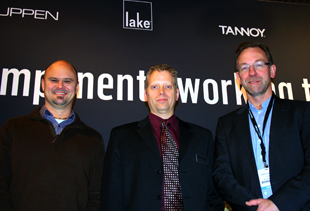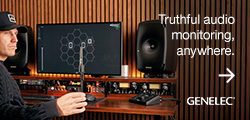 The air is thick with discussion of Audio Video Bridging. So thick, in fact, that it’s more confusing than enlightening to those not directly involved – and to some of those who are.
The air is thick with discussion of Audio Video Bridging. So thick, in fact, that it’s more confusing than enlightening to those not directly involved – and to some of those who are.
Whether you’re walking a trade show floor or surfing the industry’s social media groups, AVB can be as hard to escape as it is to understand. You need to know more...
Crucially, AVB recognises the growing difficulties that manufacturers, systems integrators and operators face. These appear at every turn – when equipment is being designed, when it is specified and installed, when it is configured and when it is in use. There is no escaping the complication that comes with the sophistication of present (and future) audio and audiovisual systems, but AVB reckons to intervene in a way that will reduce the difficulties of their use.
This starts to make sense when you consider the background to AVB – the legacy of competing and contrasting audiovisual communication and integration protocols is a minefield of alternative and mismatched ‘standards’ that fills manufacturers and systems integrators with equal levels of trepidation. An indication of this was given by Kevin Gross on LinkedIn’s AVB Group recently, with his hope that ‘AVB can be disruptive enough to tip us towards sanity’. And Kevin Gross invented CobraNet.
If it is successful in its uptake, AVB will see Ethernet technologies such as CobraNet, Dante and EtherSound pulled together under a much larger umbrella, as well as stepping across the pro-consumer border into domestic A/V installations.
The first firm steps toward this goal came in January 2010, with the publication of the (ratified) IEEE 802.1Qav specification, the first of the ‘core’ Audio Video Bridging standards. This ‘defines forwarding and queueing for time-sensitive streams’ and is part of a suite of standards developed by an Institute of Electrical and Electronics Engineers (IEEE) task group.
The alliance of science
If we are to make any useful sense of AVB we need to take a step back. Several steps back, in fact. Let’s begin with the present cast of key players.
These work with the broader IEEE 802 standards family that addresses local area networks (LAN) and metropolitan area networks (MAN). This covers a range of ‘bridging’ considerations for Ethernet, Token Ring, Wireless LAN, Bridging and Virtual Bridged LANs – with IEEE 802.1 concerned specifically with Audio Video Bridging.
While the IEEE 802.1 AVB Task Group is the body behind the defining document, another group called the AVnu Alliance has organised itself to help oversee the smooth and successful uptake of AVB in audiovisual circles, including compliance with these standards. In its own words, this is ‘an industry forum dedicated to the advancement of professional-quality audio/video by promoting the adoption of the IEEE 802.1 Audio/Video Bridging (AVB), and the related IEEE 1722 and IEEE 1733 (which extends Real-time Transport Protocol for use on AVB) standards over various networking link-layers’, and aims to promote the AVB networking standards across a broad range of markets including automotive and consumer electronics. Its founding members include Cisco Systems, Harman International, Intel, Samsung Electronics and Xilinx, with further support coming from Analog Devices, Audinate, Avid Technology, Barco, Biamp Systems, Lab X Technologies, Marvell, Meyer Sound, Sennheiser and Shure among others. The most recent signatories are Bosch Security Systems’ Communications Systems Division and the TC Group (TC Electronic, Tannoy, Lab.gruppen, Lake and TC Helicon).

with AVnu Alliance Marketing Work Group Chairman
Lee Minich (centre)
In opening, the panellists quickly outlined the mission – ‘to address the jumble of present options’, in John McMahon’s words.
The picture painted by AVB offers an audio-video network presenting less than 2ms audio latency, through seven switching hubs (worst case) at 100MB speeds (significantly lower over increasingly common Gigabit Ethernet), while retaining sample sync by using a distributed clock. It also guarantees operating bandwidth while co-existing with other devices.
On top of this technical dexterity, AVB aims to make life considerably easier for systems integrators and managers by being self configuring – avoiding conflict with connections and the need to key in IP addresses in order to identify equipment on a network. And it will be invisible to users.
The standard does not set out to define every possible remote control option over the internet, but – like the Midi control standard in the eighties – promises a framework that leaves options open to manufacturers. In this way, there is no requirement to wait for agreement on lots of specific comms protocols before new developments and equipment can be brought to market. It worked for Midi…
‘With IEEE 802.1Qav published and two additional standards nearing completion, AVnu has the confidence to move quickly in developing our AVB compliance and interoperability programmes, which are vital for widespread commercial adoption,’ said Rick Kreifeldt, AVnu Alliance Chairman and President, on the publication of the initial IEEE paper.
‘This is the first time the core technology of Ethernet switches and network bridges has specific methods defined for traffic shaping,’ added Michael Johas Teener, Chair of the IEEE AVB Task Group. This allows an IEEE 802 network to provide assured (and low) delays for streaming data with minimal lost packets. When combined with the almost-finished 802.1Qat Stream Reservation Protocol, IEEE 802.1Qav will be the fundamental toolkit to provide the kind of virtual plumbing needed for professional-quality audio-video networking.
Although not on the Plasa panel, Harman Professional CEO Blake Augsburger is on record as regarding ‘traditional’ automation and multiroom networking systems as being ‘too complicated for both end-users and installers to have longevity’.
Harman has a unique take on AVB. This is partly down to the spread of its brands and partly because of its investment in its own HiQNet. ‘We put together the SDIG [Systems Development Integration Group] about eight years ago, and started really focusing on control and monitoring,’ Augsburger said in a recent interview. ‘We were moving data around with CobraNet, then about two years ago we got very involved in the AVnu Alliance. Up to that point we were able to move data over an Ethernet cable – we knew it was going to get there but we didn’t know when it was going to get there; you’d have all sorts of jitter [sync accuracy] problems. What Ethernet AVB did for us was it solved that jitter problem and then it also allowed us to increase the bandwidth so we could move audio and video.’
In the words of Product Application Specialist Tom Cram, who has long involvement in HiQNet’s development, ‘It was kind of like letting go – good for the industry but hard for Harman. Now it’s in the industry’s hands…’
Real-world networking
‘The key for us – and I think the key for this business in general – is that we have to simplify the installation,’ Blake Augsburger summarises. ‘Today, to do a Crestron or AMX system, you have to be trained and constantly stay up on the training. How do we simplify that whole process?
‘Our goal is to make it easy-to-use, plug-and-play. That would mean guys [integrators] can lower their costs. If you look at a contractor on the professional side, if he’s going to put in a system he’s got to have somebody on his staff who’s an expert at every component,’ he adds. ‘It’s the same thing for a residential installer. If he’s going to put a system in, he’s got to have somebody on his staff who knows everything.’
One of the key aspects to AVB’s operation is that it is an isosynchronous protocol – one that overcomes the synchronisation issues referred to by Augsburger by using its own clock. According to the specification, AVB allows the transmission of audio and video streams to be synchronised within a microsecond of each other, with low delay, and with minimal lost data due to network congestion. The range of delay and amount of lost data will depend on the particular network technologies (Ethernet, wireless...) on the stream path.
AVB looks set to deliver the aims identified by Blake Augsburger, as it will support the complexities of present (and desired) A/V networks without demanding comprehensive knowledge of the complex configuration typically required today for infrastructure devices, such as gateways and switches.
It also guarantees the necessary bandwidth of different communications for ‘forward communication’ – that is, traffic that has yet to be sent. If such a reservation request is granted, the traffic is protected from competing unreserved traffic. This is set against the system’s ability to protect itself from reservation requests that would cause the total to exceed a maximum percentage of the available bandwidth on any given link.
Because reservation requests are assessed at each network hop via the reservation protocol, there is no need for manual configuration of priority, VLAN, and Layer 2 multicast addresses in the infrastructure devices, as is currently required by some proprietary solutions.
The core standards that AVnu Alliance is looking to are covered in the IEEE 802.1 Audio/Video Bridging (AVB) draft standards. These include:
Why will AVB succeed?
AVB’s advocates are unanimous in their confidence. ‘AVB is the evolution of Ethernet,’ states Lee Minich, President of Lab X Technologies and AVnu Alliance Marketing Workgroup Chairman. ‘Whereas other proprietary protocols have tried to work around the shortcomings of “legacy” Ethernet, AVB makes the fundamental changes to the underlying infrastructure to make Ethernet AV media aware.’
AVB is part of the established Ethernet standard, and is capable of supporting both audio and video networks – not only in pro audio and video applications, but using different manufacturers’ products in complex systems such that they can be treated as a single device. Furthermore, it is appealing to a variety of different industries – and this also is key, as some of those other industries are very large and will play a major part in driving AVB’s development forward, as well as bearing the brunt of the development costs.
Under the hood, AVB connects devices in a ‘network style’, yet promises to be more flexible than point-to-point protocols. It will also be quick to set up, lowering installation costs and the level of expertise required to implement, operate and maintain an AVB-based installation.
It readily allows a network to be monitored, and to provide confidence monitoring, flagging of failures, and the splitting and sharing of signals. It also lends itself to remote control, so that installations can be programmed, monitored and controlled from distant sites. As well as the systems owners or operators, this could include third-party maintenance, further relieving operators of the necessity for in-house expertise.
As it stands, some manufacturers are already implementing AVB support in their equipment, with others announcing their intent to follow. This ready take-up looks likely to generate the critical mass to guarantee AVB’s success.
To close 2010, Lee Minich did a straw poll on LinkedIn, asking what the biggest impact of AVB was in 2010, and requesting AVB related predictions for 2011. The volume of response itself was a measure of current interest in AVB. And the comments made were a good reflection of people’s positions and concerns. Among them, Avid’s David Gibbons offered a balanced summary: ‘I’m very excited by the momentum that has gathered around AVB during 2010, and continue to feel good about Avid’s commitment in live sound to both the standard, and to the AVnu organisation,’ he said. ‘I predict we'll see continued acceleration in 2011, some significant AVB-based product introductions, solid progress and closure on standards ratification, and general consensus (particularly in pro audio) from both manufacturers and their customers that this is the right solution for everyone to get behind.’












